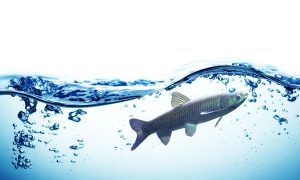Dissolved Oxygen Theory and Measurement
Dissolved oxygen (DO) is a measure of how much oxygen is dissolved in a system. Measurements are usually taken in water using a DO probe and meter. Henry’s Law states that the concentration of gas in a solution is directly proportional to the partial pressure of that gas above the solution. Henry’s Law constant is a factor of proportionality, and so is specific to the gas in the solvent being measured.
The partial pressure of oxygen is in fact a measurement of the thermodynamic activity of its molecules. The rate at which oxygen dissolves, diffuses, and reacts is not determined by its concentration, but by its partial pressure. The Earth’s atmosphere is composed of 20.9% oxygen, and at sea level the atmosphere is 100% saturated with oxygen.
Percent saturation is the amount of DO present per amount of DO possible at a given temperature and pressure. Percent saturation is a common unit for DO measurement since it is based upon the partial pressure of a gas; thus it is correct for determination in any solvent.
Concentration measurements of DO can also use the units of parts per million (ppm) or milligrams per liter (mg/L). In meters that report DO concentration in ppm or mg/L, the solvent is always assumed to be water. In other solvents such as oils or acids, the Henry’s Law constant would be different. In those cases, percent saturation should be used as it is incorrect to use ppm or mg/L.
Effects of Temperature and Pressure
As the temperature of a solution increases, the particle movement within that solution increases. With greater particle motion, dissolved gases escape more readily from solution. In warm water, oxygen is less soluble while in cold water, oxygen is more soluble. DO concentration in air saturated waters decreases with increasing temperature.
Atmospheric pressure decreases as altitude increases. Since there is lower partial pressure, oxygen is less soluble at higher altitudes. DO concentration in air saturated waters decreases with increasing elevations.
Applications
Water quality measurements are vital to environmental monitoring. In quiescent lakes and rivers, the decay of organic matter can cause bacteria levels to increase. The aerobic bacteria consume oxygen, triggering a deficiency that can cause a water body “to die,” killing aquatic plants and animals.
Aquaculture is the breeding, rearing, and harvesting of plants and animals in all types of water environments. Dissolved oxygen is needed by fish, zooplankton, and plants to survive and reproduce. DO measurements are used to monitor and control the environment required for success.
Wastewater treatment plants rely on bacteria to break down the organic compounds found in water. If the amount of dissolved oxygen in the wastewater is too low, these bacteria will die and septic conditions will occur. The amount of DO must be consistently monitored to ensure proper waste treatment.
Laboratory Monitoring of BOD, OUR and SOUR
BOD (Biochemical Oxygen Demand) is a measurement that indicates the concentration of biodegradable organic matter present in a water sample. It can be used to determine the general quality of water and its degree of pollution. BOD measures the rate of oxygen uptake by microorganisms in a water sample at a fixed temperature over a given period of time. To ensure that all other conditions are equal, a very small amount of microorganism seed is added to each sample being tested. The samples are kept at 20°C in the dark for five days. The loss of dissolved oxygen during incubation is called the BOD5. BOD is an empirical test that determines the relative oxygen requirements of wastewater, effluent, and polluted waters.
OUR (Oxygen Uptake Rate) is used to determine the biological activity of a system in terms of oxygen consumption or respiration rate. It is defined as the milligrams per liter of oxygen consumed per hour. This measurement indicates the rate of metabolic processes in sludge treatment, helping operators determine the stability of solids after digestion.
SOUR (Specific Oxygen Uptake Rate) also determines the oxygen consumption of a system, but is defined as the milligrams of oxygen consumed per gram of volatile suspended solids (VSS) per hour. This quick measurement has many advantages: rapid measure of influent organic load and biodegradability, indication of the presence of toxic or inhibitory wastes, degree of stability and condition of a sample, and calculation of oxygen demand rates at various points in the aeration basin.
Types of Dissolved Oxygen Probes
Hanna’s dissolved oxygen meters utilize one of two common types of sensing probes: polarographic sensors and galvanic sensors.
Polarographic DO probes consist of a working electrode (cathode) and a counter electrode (anode). A polarizing voltage is applied to these electrodes that is specific for the reduction of oxygen. A thin, gas permeable membrane isolates the sensor elements from the water sample but allows oxygen to pass through. The oxygen that passes through the membrane is reduced at the cathode, causing a current from which the oxygen concentration is determined. Two-electrode polarographic probes use the anode as a reference electrode.
Galvanic DO probes consist of a working electrode (cathode) and a counter electrode (anode) that act as a battery to produce a voltage specific for the reduction of oxygen. A thin, gas permeable membrane isolates the sensor elements from the water sample but allows oxygen to pass through. The oxygen that passes through the membrane is reduced at the cathode, causing a current from which the oxygen concentration is determined.
Wine and beer are both affected by oxygen at various stages during production and storage. DO is an important parameter to monitor for those who wish to produce consistent, high quality products.






